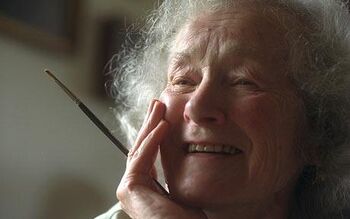
Pauline Baynes.
Pauline Diana Baynes (1922-2008) was an English illustrator, most famous for illustrating The Chronicles of Narnia.
Biography
Early Life and Family
Daughter of Frederick Baynes and Jessie (née Cunningham), Pauline Baynes was born on the 9th of September 1922 [1], in Hove. She spent her early years in Agra, India, where her father was a commissioner in the Indian Civil Service. When she was five, her mother took her and her sister Angela to England, to attend school. She spent the next few years unhappy at a convent school, where the nuns made fun of her active imagination and her ability to speak Hindi. After this, she attended the Beaufront girls' boarding school, Camberley. When she was 15, she spent two terms at the Farnham School of Art before moving on to the Slade, and then to Oxford.
Early Career
In 1940, she and her sister, Angela, were sent by the Women's Voluntary Service to the Royal Engineers' Camouflage Department and Training Centre at Farnham Castle, as model makers. By 1942, she was drawing charts for the Admiralty at their Hydrographic Department in Bath. After the war, she kept house for her widowed father.
She worked as a teacher at Farnham, where she developed a reputation as exacting and meticulous. In 1948, her portfolio with George Allen & Unwin was shown to J. R. R. Tolkien. He was looking for an illustrator for his book Farmer Giles of Ham. Baynes did such a good job on the commission that Tolkien was to comment later that her pictures had succeeded in reducing his text to 'a commentary on the drawings'.[2]
Marriage
In 1961, Baynes met the local dogmeat man, Fritz Otto Gasch[3], a German ex-POW who had been with Rommel in Africa. Within weeks they were married, and Gasch subsequently set up business as a garden contractor. He created a beautiful garden for her, where they spent many hours, and remained a devoted couple until his sudden death in 1988.
Establishing a Reputation
Her friendship with Tolkien led to a meeting with C. S. Lewis, which led to commissions for each of his seven Chronicles of Narnia. While never as close to Lewis as she was to Tolkien (he maintained she couldn't draw lions), the illustrations for the series became part of the experience that was Narnia, and she returned to the books several times over the years.
Between 1965 and 1968, she illustrated Grant Uden's Dictionary of Chivalry, for which she won the Kate Greenaway Medal, and which she considered some of her finest work. Its margins contain a staggering 600 illustrations with fantastic detail and unerring accuracy.
Later Work
She continued to work, pouring out a prodigious quantity of excellent illustrations, including Henri Pourrat's A Treasury of French Tales; Amabel Williams-Ellis' Fairy Tales from the British Isles, The Arabian Nights, The Hobbit, and a paperback edition of Watership Down.
She also began writing books, including Victoria and the Golden Bird (1948), How Dog Began (1985), Good King Wenceslas (1987), and The Elephant's Ball (2007).
She continued working right until the very end, creating illustrations for the Koran (published in 2009), the Book of Job, and, at the time of her death in 2008, was working on very colourful illustrations for Aesop's Fables.
She died on the 1st of August 2008, and her ashes are scattered in her beloved garden, overlooked by the window of her studio.
Style
Baynes' style is marked by an obsessive attention to detail, and painstaking research into period costume and architecture. She was especially fond of drawing animals, in particular dogs, which were her constant companions. She is noted for her superb mastery of fluid line, gem-like colours, and the use of negative space.
